variation in populations
1/107
Earn XP
Description and Tags
* means that you don't need to know it.
Name | Mastery | Learn | Test | Matching | Spaced |
|---|
No study sessions yet.
108 Terms
species
a group of similar organisms that can interbreed in nature and produce vigorous, fertile offspring
→ means that their offspring will survive to reproductive age and then produce offspring of their own that can also reproduce
subspecies
different races of the same species, who do not interbreed directly, but gene flow still exists
e.g. tigers: bengal, siberian, simatran
they can technically interbreed but they don’t really because their geographic location is different
extinction
the permanent loss of a species
no evidence or sightings for at least 50 years
if referring to small group, say extinction of population
population
a group of organisms of the same species living in a defined geographic region at the same time
e.g. wombats: population of northern hairy-nosed wombat
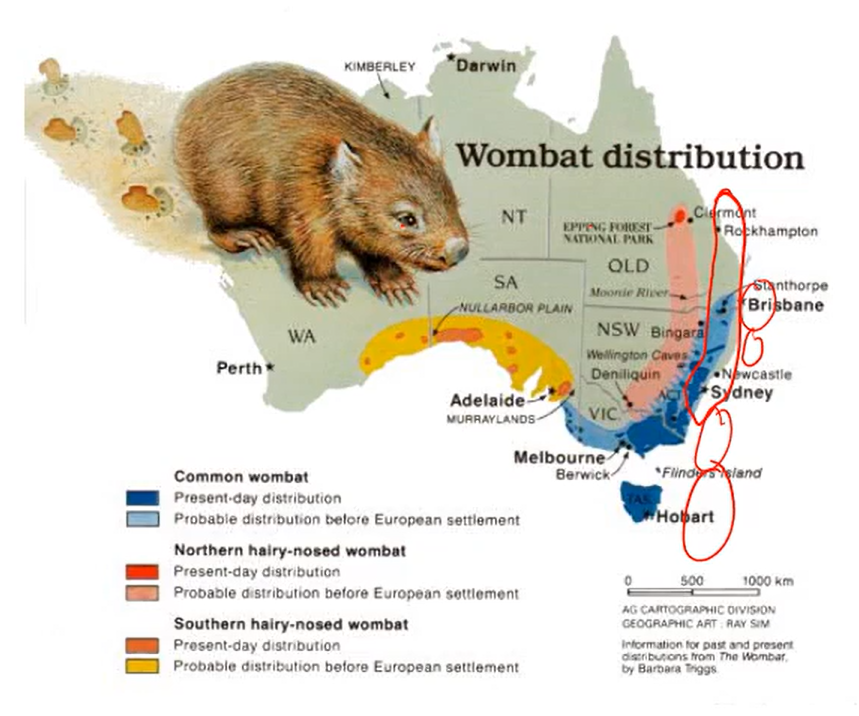
gene pool
the genetic makeup of a population; includes the sum of all the alleles for different genes present in a population
→ basically all of the alleles that are present for the different genes within that population makes up their gene pool
What is an allele?
a different variation of a gene. genes code for proteins, so we have somewhat different proteins produced in different individuals
gene flow
the movement of genes and alleles between populations.
gene flow increases the genetic diversity within a population
why is variation important?
important for a population to survive any sudden change in their environment
*variation occurs when members of a population display different phenotypes (traits)
e.g. *physiological, structural or behavioural traits.
sources of variation
reproduction → passing alleles to offspring
gene mutation/mutation in alleles
environment causes phenotypic variation (e.g. tanning)
How can you measure genetic diversity?
by examining the gene pool of a population and calculating the allele frequency
What does it mean if a population has a wide range of alleles?
they are genetically diverse
For Hardy Weinberg what does P and q mean?
P - dominant allele
Q - recessive allele
genetic drift
the random changes in allele frequency due to chance events
What kind of population does genetic drift have a more pronounced effect in?
more pronounced effect in small populations, and this can result in the loss or fixation of an allele
this results in reduced genetic diversity in small populations.
in this pic, blue is fixed and red is lost ☹
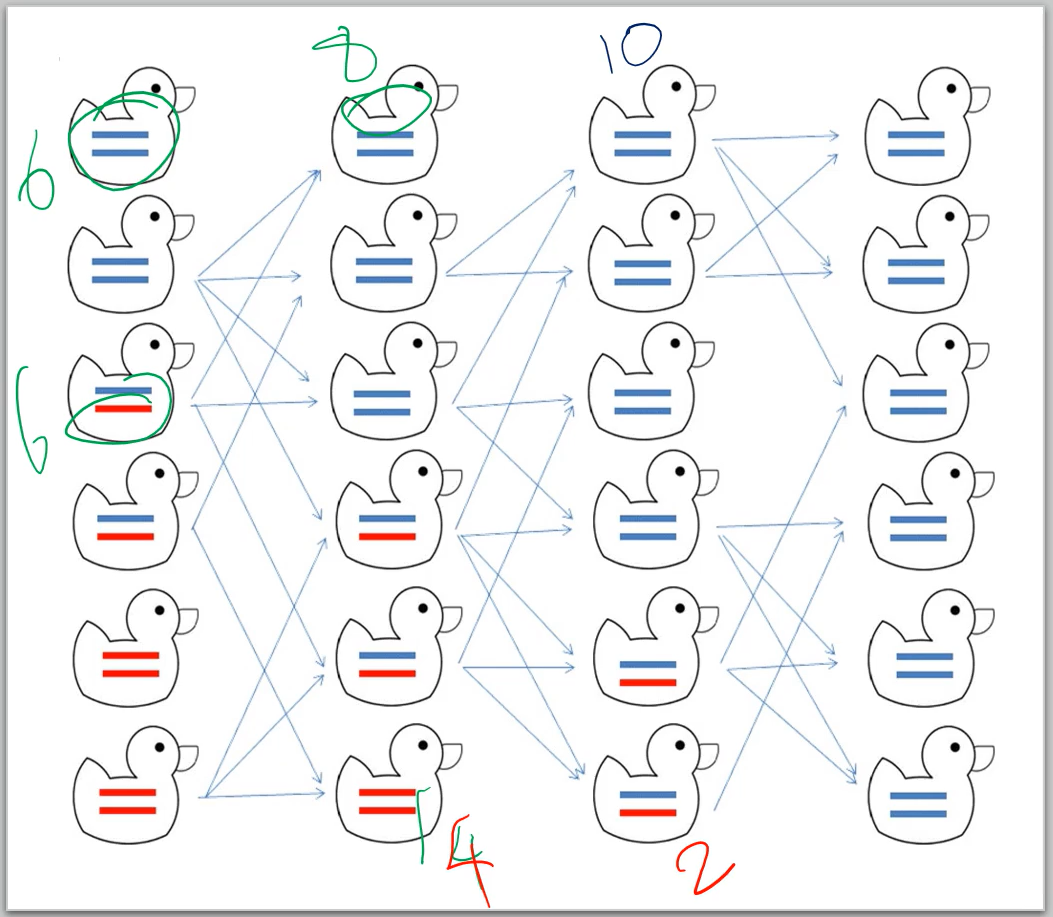
types of genetic drift/allele frequencies changing in a population
founder effect, bottleneck effect
the founder effect
occurs when a few individuals migrate to create a new population in a different geographic location that is not representative of the original population
allele combinations are different from original population AKA the individuals are genetically different to the og population, resulting in a different gene pool → *they will be very different genetically
since there are only a few founding individuals, there will be very low levels of genetic variation
*it’s basically the result of inbreeding?😟
the bottleneck effect
the severe reduction of individuals in a population generally due to a catastrophic event such as disease, bushfire, or human impact
population will increase in numbers over time, but genetic variation stays low as the gene pool only comes from surviving individuals
→ *inbreeding again 🤕
Fossil record
fossils appear in an order of ‘fossil succession’ from single cellular organisms to structurally complex multicellular organisms
several mass extinctions have occurred throughout Earth’s history
What opportunities do mass extinctions provide?
mass extinctions provide opportunities for other species to thrive and diversify
fossil
the remains of an organism or direct evidence of its presence on Earth
Is the fossil record complete, and why?
it is incomplete because:
most organisms do not get fossilised due to the conditions required to do so
or the fossils are too old so the DNA is degraded and scientists are unable to identify the organisms and where it fits in the fossil record
Where are most fossils found?
in sedimentary rock
How are fossils mostly formed?
through the process of mineralization, where
hard body parts are replaced by hard minerals as the surrounding sediments turn into rock
Why do we not find fossils in igneous (volcanic) rock?
it’s probably too hot so they js die
conditions for fossilisation (RUD)
fossilisation is very rare, but when it does happen:
Rapid burial - covered in sediment; usually underwater. it gently overlays body
Organisms lies Undisturbed - no predators, no earthquakes, etc. do not want disturbance
Decomposition is prevented - bones/hard parts. Low O2, low temp, low moisture, to prevent bacterial decomposition
types of fossils
body, trace, index, transitional
body fossils
fossils of the actual organism
e.g. bones, teeth and claws
soft tissues such as skin, muscles, and organs are very rarely fossilised
trace fossils
not the actual organism. e.g. burrow, footprint, faeces
index fossils
a fossil that:
had a wide geographic distribution
existed for a relatively brief period of time
fossils that are found in the same rock layer can be estimated to be the same age.→ form of relative dating
transitional fossils
intermediate forms of organisms that provide an evolutionary link between species.
dating techniques
relative dating, absolute (radiometric) dating
relative dating
the age of the rock is determined by comparing it to another rock
stratigraphy/stratification:
the study of the sequence of rock layers (strata) in any one area
layers deposit over time
older layers are lower
uses index fossils → fossils in the same layer estimated about same age
⭐️ a fossil’s relative age is provided!
absolute (radiometric) dating
provides a numerical (absolute) age for a fossil
based on radioactive isotopes and their half-lives
half life - the time taken for half of the parent isotope to decay into its daughter isotope
describe the difference between relative and absolute dating
relative:
uses the Earth’s layers to determine whether one fossil is older than another based on the position in the rock layers. (older fossils lie deeper than younger fossils)
absolute:
uses the decay of certain elements to calculate the actual age of a fossil. (half life = time taken for half of a sample of atoms to decay.
carbon dating
dating organic fossils that contain carbon. they must be less than 50,000 years old, otherwise radioactive isotope cannot be isolated.
it is easy to extract carbon from mummified carcass
selection of phenotypes
why are some individuals more likely to survive
some individuals are more likely to survive change in their envronment due to a particular phenotype
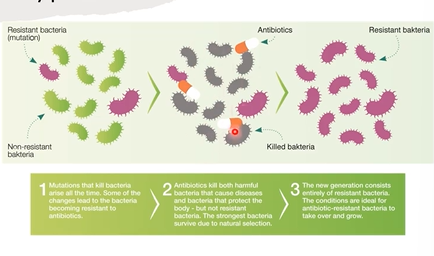
How does variation exist in the population?
through mutations that may have created new alleles or by different allele combinations in sexual reproduction.
Recall the process of Natural selection, what variation means for individuals in a species, and what the result of this is
variation exists in individuals within a species that may lead to an advantage if a change in the environment occurs
a selection pressure present in the environment acts on that variation
→ this means some individuals in the population have a survival and reproduction advantage
individuals that survive pass on the allele to the next generation through reproduction, resulting in more individuals with the trait.
→ this results in increased allele frequencies for the trait in the population
it acts on certain individuals in a population, not the whole population
selective breeding
a human (usually a farmer) selects the trait that is desired based on phenotype
selects two organisms that display the trait, and breeds them → to increase the chance of offspring having these traits
observes the offspring, and then selects the offspring with the best version of the desired trait. Breeds the offspring
completes the process many times until the trait is observed in all offspring
selection pressures *
predators
availability to resources (water, shelter, mating habitat)
food sources
disease/pathogenic spread
environmental phenomena (natural disasters)
weather conditions/changes (e.g. floods, storms, etc)
abiotic conditions (e.g. temp, CO2 concentrations)
half life
the time taken for half of the parent isotope to decay into its daughter isotope
half life of carbon?
approx. 5730
speciation
process by which new species are formed
what is allopatric speciation?
speciation due to geographic separation
Steps for allopatric speciation
There is variation and gene flow in a population living in a specific geographic area
A geographic barrier separates the population (e.g. a river *or mountain range forms), and gene flow stops
Different selection pressures on either side of barrier. Different phenotypes are selected for on either side
Over time, many different mutations occur in the different populations, and they accumulate resulting in phenotypic differences
The two population become so different that they become reproductively isolated. If the two populations were brough back together, they could not interbreed. A new species has formed
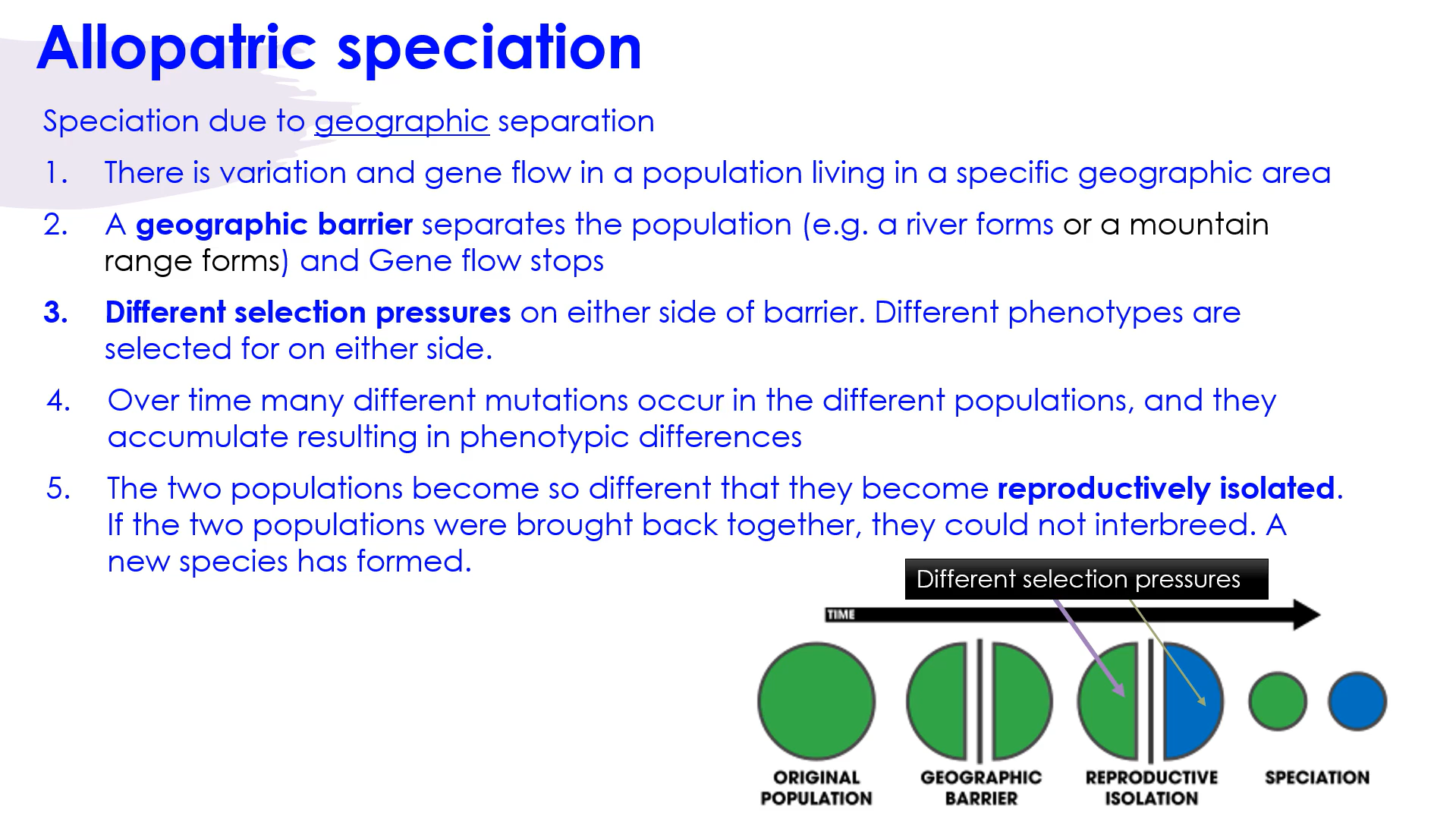
Galapagos Finches
acestral finch arrived from mainland South America and increased in population. Some of them flew to other islands with different selection pressures like food source.
Over time, the beak shapes changed and the finches became so different on each island that they became different species
Sympatric speciation
speciation due to reproductive separation
Steps of sympatric speciation
There is variation and gene flow in a population living in a specific geographic area
A reproductive barrier prevents some members of the population from reproducing, such as mating at different times of the year
Over time, many different mutations occur in the different populations, and they accumulate resulting in phenotypic differences
The two populations become so different that they become reproductively isolated. Although the populations live in the same niche, they cannot interbreed. A new species has formed!
Howea palms- Lorde Howe Island
example of sympatric speciation, when two species from a single ancestor form in the absense of a geographical barrier.
the two species diverged after they began flowering at different times of year, as a result of soil preferences
selection pressure
a factor in an organism’s enironment that will result in the death or inability to reproduce for unsuited individuals
What genetic evidence could show that two populations are different species?
Scientists could compare:
DNA sequences
mitochondrial DNA or
conduct comparative genomics.
Significant genetic differences indicate long-term reproductive isolation, supporting that the populations are separate species.
structural morphology
the study of the size, shape and structures of plants, animals, and microbes, as well as the interactions between their parts
this helps us determine whether there is a common ancestor or not
THIS IS HOMOLOGOUS, AND ANALOGOUS
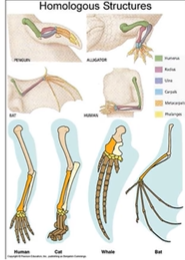
Homologous structures
have the same structure but may have a different function
evidence of different selection pressures
evidence of a common ancestor (divergent evolution)
*example: pentadactyl structure: people’s arms, bats wings
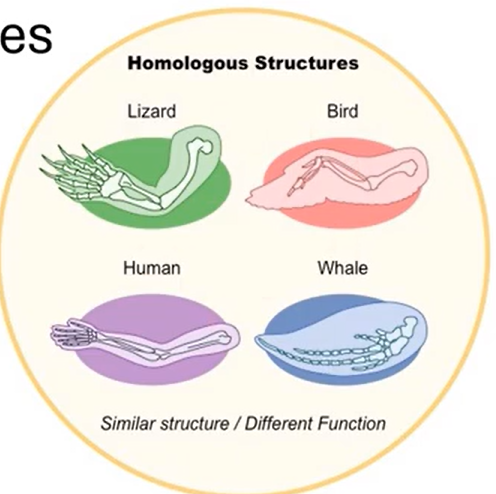
Analogous structure
a different structure but the same function
due to similar selection pressures
no common ancestor
example: flippers/fish tails. they look different but they all need to swim
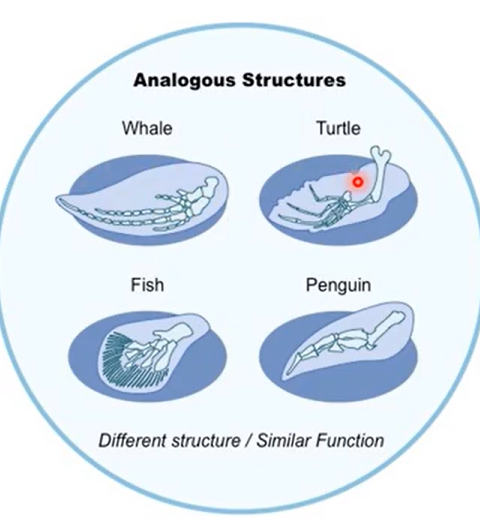
Vestigial structures
a feature that a species inherited from an ancestor but that is now less elaborate and functional than in the common ancestor.
*→ the selection pressure for that feature to be maintained is no longer there
example: whales still have a pelvic bone but it’s very small due to lack of selection pressure (e.g. live in water vs on land)
Molecular homology
the study of the similarity or difference of molecular information, using nucleic acid or amino acid sequence
Advantages of using nuclear DNA
large number of genes to compare because there are more nucelotides vs amino acids, and therefore greater comparison
higher variability than amino acids as genes will contain introns and exons
more variablity in introns compared to exons, as they don’t code for the protein, as it will not affect function
changes in nucleotides don’t always mean a change in amindo acid: redundancy/silent mutations
recombination occurs: *can account for variability within a species
*higher chance of degrading
advantages of using mitochondrial DNA
maternal inheritance; no complication of recombination compared to nuclear
smaller number of genes
a positive: there is large number of copies per cell compared to nuclear
→ *less likely to degrade
Amino acids
changes in amino acids may indicate a function change in the protein
sequences are smaller: 1 amino acid for 3 nucleotides,
may increase sensitivity of analysis as there are 20 amino acids compared to 4 nucleotides
more conserved than DNA due to amino acids making up the protein and it is important to maintain specific shapes for function
what do you do in sequence alignment
compare the sequences and identify differences and similarities
Molecular clock theory
the greater difference in the nucelotide/aminoacid sequence indicates
there has been more time for mutations to occur and accumulate and more time since divergence from a recent common ancestor
Phylogenetic trees
a diagram showing evolutionary relationships; can be for a single gene or genome
usually created with molecular evidence; nucleic acid or amino sequences, but can be created based on structural evidence as well
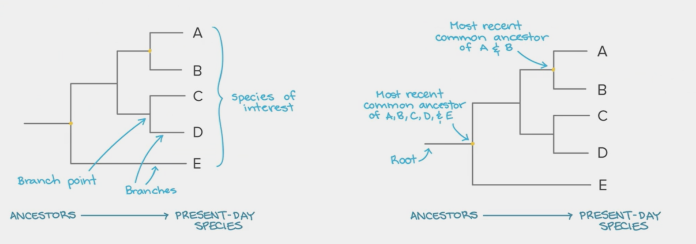
mammals
a class of animals with vertebrae
shared features of mammals
mammary glands to feed young milk
have hair/fur on surface
three middle ear bones
sweat gladnds
all give birth to live young (except monotremes)
neocortex region in the brain (sensory perception, cognition, spatial reasoning)
Primates
evolved from ancestors that lived in trees
Primate characteristics
prehensile hands and feet with fingertip pads that are sensitive
opposable thumbs (allows power grip and precision grip)
fingernails instead of claws
well developed collar bone and rotating shoulder joint
large forward facing eyes protected by bony eye socket
separated big toes that face forwards
large brain volume compared to body size
penis and testes that permanently hang down from the body
Hominoids - “Apes”
gibbons, orang-utans, chimps, gorillas, and humans
excludes monkeys
Features of hominoids
no tail (monkeys have a tail)
long arms
full rotation of shoulder joint
broad pelvis
upright (or semi-upright)
wide shallow chest cavity
larger brain relative to body size compared to other primates
increased complexity of cerebrum
increased intelligence (problem solving etc)
Hominids - Great Apes
orang-utans, gorillas, chimpanzees and humans
Hominini
taxomic tribe
homo sapiens and extinct hominins
chimpanzees
Hominins
all human species and their bipedal ancestors
Features of hominins
bipedal; walk upright
arms shorter than legs
not much hair
more sweat glands
wrists and hands can rotate and manipulate objects
have relatively large brains to body size
cultural evolution
arched foot
smaller canine teeth
no tail
big toe more in alignment with other toes
opposable thumbs but not toes
evidence for hominin evolution
skull changes, brain volume, cerebral cortex, cultural evolution
major trends in structural evolution of the skull in hominins
reduced brow ridge
loss of the large bony crest on top of skull
flatter, smaller faces
reduced zygomatic arches and sagittal crest
reduced jaw bones
reduced jaw muscles
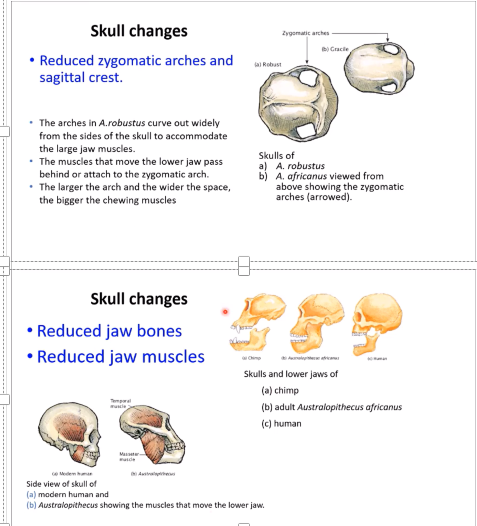
Hominin features other than skull and cognitive that show evolution
development of larynx and associated muscles
speech
hair reduction due to less parasite infestation, thermoregulation
more sweat glands; greater endurance
Major changes in evolution of the brain in hominins
larger brain cavity size relative to body size and therefore an inferred larger brain size
increased cerebral cortex so and complex thought
delete
increased cerebral cortex and complex thought
Cultural evolution
the passing on of information; teaching
due to changes in biological evolution; brain capacity and pharynx/larynx
includes:
travel
language and communication
passing on of knowledge
food, art, music, etc
traditions, beliefs, religion
Types of evolution
biological evolution
cultural evolution
functional changes
structural evolution
cognitive changes
Biological evolution
changes in the DNA that results in changes to morphology and structure
Structural evolution
changes in anatomy especially bones e.g. changes in foot, spine, and skull structure
Functional changes
changes in the way the organism operates e.g. changes in biological systems
Cognitive changes
changes in brain size and complexity and consequently thinking processes
cultural evolution
the passing on of information (teaching) between generations
Evidence for bipedalism - head/skull
foramen magnum has become centralised
allowing attachment of spine and spinal cord directly under the skull
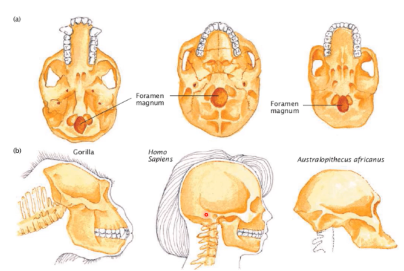
Evidence for bipedalism - spine
change in vertebra and spinal column
S shaped spine in homo sapiens, allows to stand fully upright and bring spine under the centre of skull. it helps for weight to be distributed evenly
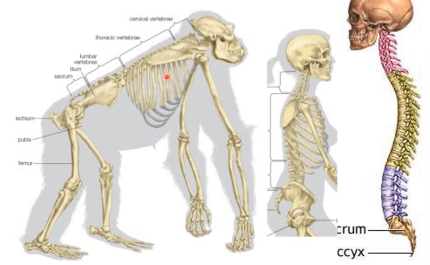
Evidence for bipedalism - pelvis
pelvis has become broader and more compact; bowl shaped
better weight bearing capacity
allows an upright stance
more support and space for organs
wider attachment of femurs (thigh bone)
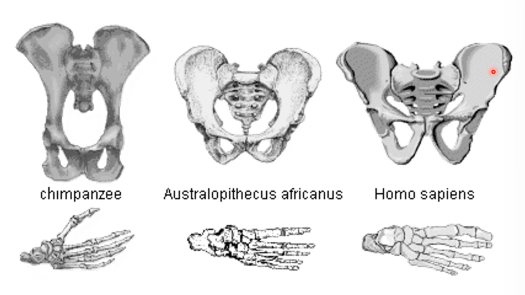
Evidence for bipedalism - femur
femur is more angled towards the knee, this allows for a smooth bipedal motion
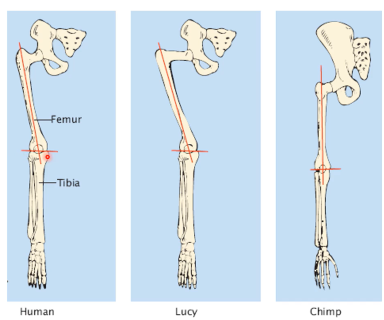
Evidence for bipedalism - foot
big toe aligned to the other toes, which allows for better heel strike when bipedal; more efficient gait
big toe helps push off the ground
arched foot helps with a more efficent stride/gait
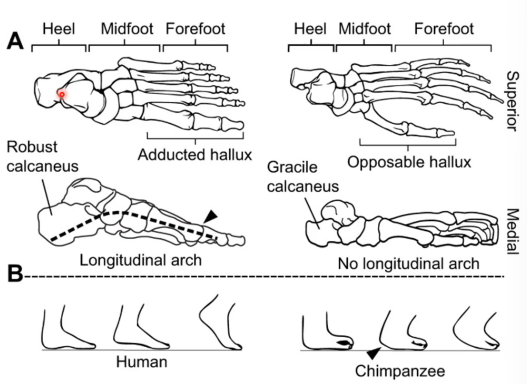
Hominin arms
structure of collar bone, shoulder blade, and arm
shoulder joint point sideways, but in older hominins more upwards
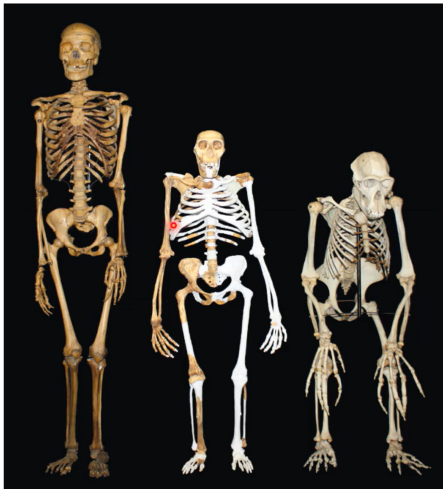
Evolution of the hominin hand
change in hand proportions - larger thumb more closely aligned to finger lengths
thumb musculature increased; greater load
wrist mobility has increased
finger bones have decreased curvature
sensitiveity of fingertips
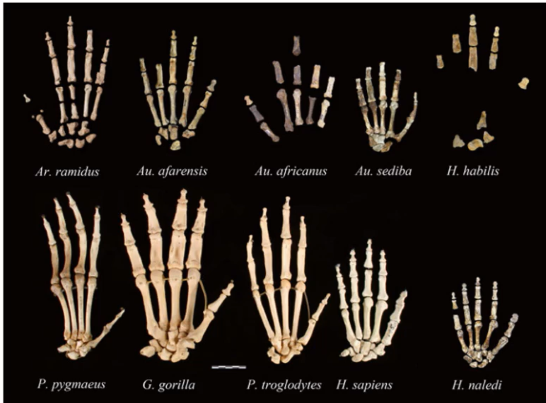
There is often disagreement about new fossils and where they belong in human evolution. Why?
the fossil record is incomplete (and there is a lack of viable DNA evidence) which results in different interpretation of evolutionary links
as more evidence (fossil and DNA) is discovered, our understanding of human evolution is altered
How do we know about our history of interbreeding
analysis of mtDNA and nuclear DNA has indicated genetic relationships between Homo neaderthalnsis and early modern humans (Homo sapiens)
How much Homo neanderthalensis DNA in our populations?
Genomes of European populations and Asian populations contain approximately 1-3% Homo neanderthalensis DNA
What populations share DNA with Denisovan
papuans, some Polynesians and Indigenous Australians share DNA with Denisovan
What two species also interbred
Denisovan and H. Neanderthals
Human migration - where did it start and what occurred during this time
Early hominins evolved in Africa, and began migrating out of Africa as early as 2 million years ago. Homo Sapiens started migrating out of Africa around 150,000 years ago into Europe and Asia first
gene flow occurred during this time, and DNA evidence shows interbreeding between homo sapiens and homo neanderthalensis
Human migration - when and how did they arrive to Australia + evidence BITCHHH
modern hominins arrived in Australia approximately 65,000 years ago through South East Asia - via existing land bridges
groups migrated down the east and west coasts of Australia rapidly after arrival
Australian megafauna e.g. Diprotodon - a large womabat shaped animal, became extinct around 42,000 years ago, giving evidence for rapid migration of humans around Australia
Where and how did Aboriginal and Torress Strait Islander peoples migrate to the Australian continent?
migration for these travellers was a difficult task
aboriginal and Torres Strait Islander people arrived from Sunda which was separated from Sahul and Australia by a great expanse of water
Sahul and Australia were connected by a land bridge at the time; this is now under water ☹
What evidence supports the prolonged connection of Aboriginal and Torres Strait Islander Peoples with the Australian continent?
evidence including cultural artefacts, demonstrate a prolonged connection with specific populations in Australia, in agreement with Aboriginal and torres Strait Islander People’s cultural beliefs, and connection with Country and Place